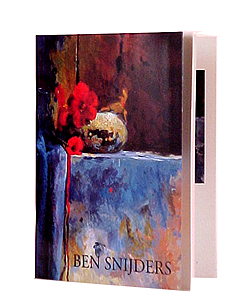Ben Snijders

|
Moments of Silence (catalogue published at the occasion of Ben Snijders' solo exhibition, October 6-30, 1999, compiled and written by Koen Nieuwendijk) Some Ordinates There is something endearing about the fact that in a tiny country such as the Netherlands, where nothing seems more important to the official art world than to present a distinctly international profile to foreigners, to the point where it is precisely that which foreigners see as so typical of the Netherlands which is ignored, regional distinctions are made within our teeny-weeny sector of realist figuration. And yet there is something to be said for it, I have to admit. What I am referring to is the intermittent use of the adage "Northern Realists", a term which is used to denote painter birds of different figurative feathers who reside in the north of the country, the province of Groningen in particular. This has everything to do with the "Minerva" Academy of Fine Arts, whose students were simply taught to paint during all those laborious years of complicated art theories by teachers who themselves had above-average proficiency in their field, and continue to do so, for the qualities of people such as Matthijs Röling, Wout Muller and Ger Siks (to name but a few) are beyond dispute. Ben Snijders (who, incidentally, lives in the province of Drenthe), contemporary of Matthijs Röling, is another example of someone who has been classified as a Northern Realist - and one of their finest, I might add. But there is also a less obvious side to all this. The survival into the late 20th century of the still life and the nude as genres of painting will not have gone unnoticed, I'm sure. However, no-one would have predicted as recently as ten years ago that these genres would take such huge flight. That the art of painting was dead was something which had already deteriorated into a worn-out metaphor which had gone out of vogue many times, only to be brought back to life as frequently; however, the scourge of innovation was upon us all, and "Northern Realists" was a term which nobody would have been brave enough to out loud. Not that Ben Snijders ever let this affect him one way or the other - he had been a star since the Dutch Art Fair 1977, the first-ever art fair to be held in the Netherlands, in the "Koepelkerk" Church in Amsterdam. It wasn't long before Ben decided to join Lieve Hemel Gallery - the start of a fruitful partnership which so far has lasted over 20 years. Snijders continued to evolve in his work. His style loosened up, the light deepened, the pictorial subduedness underwent an unusual transformation towards the utmost modesty in the choice of subjects in combination with an intensification of colour and light while a new aspect was introduced - new for Snijders, in any event, and forever fascinating: the nude both as a portrait and as a still life. As examples of the unpredictability of the questing process go, it doesn't get much better than this. Snijders is always focused on his nudes - as if he produces his little portraits between jobs. But even if he did, that doesn't detract one bit from their thrust. Behind the scenes (so to speak) a continual search is under way for the right model, with Snijders returning time and again to those of whom wonderful paintings already exist - Ruth, Fleur, Sanne. And then, all of a sudden, we meet an unfathomable, almost dark gaze with an equally mysterious and exotic name: Golbarg. But when Snijders deals with the portrait of two eggs, it suddenly becomes clear how narrow the gap between the still life and the nude is, how impossible it is to subordinate an imaginary world to a subject, how the psychology of passion refers to a world in which figuration is a tool rather than a goal. The same is true of abstraction, something which Snijders also likes to indulge in. Surfaces some of which are ever so sparsely filled with colour and light appear to be leading a life of their own in many of his paintings, light years beyond the notion of material expression. Of course the various figurative elements confer a figurative function on each adjacent plane, but the human eye can always decide to focus only on that particular element, to keep looking until the recognisable environment blurs into a pure interplay of paint texture, of sparkles, to a source of light and breathtaking beauty. Notes to a blue larkspur Snijders's work has had a distinct influence on my own development as a gallery owner. I was a bit of a stickler for the rules when I first started out, in that I had a very strong preference for detail. Whenever I was compiling an exhibition featuring Ben Snijders' work, I often found myself opting in favour of his more detailed works. Ben never challenged me - there was plenty of work to choose from, so why interfere? And yet he has always been something of maverick in a Lieve Hemel context, in that he will use a broad brush or even a palette knife whenever he thinks he should, and in that he is one of the very few painters who successfully combines an impressionist style with an immensely detailed approach in a single painting - and that sparked a process in my own head. It was thanks to Ben Snijders that I started broadening my range of vision, learning also to appreciate pictorial beauty in paintings that were not excessively detailed - so that later on, almost by way of a reward for my efforts, I was re-acquainted with the works I had initially put to one side, and which I now consider to be of overwhelming beauty. Snijders's painting entitled "Still Life with Larkspur" is a fine example. |
TOP